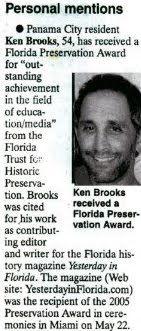It should have been a ho-hum trip, one of hundreds engineer Ray Shores had made between Panama City and Dothan, Alabama, for Bay Line Railways. It was 2 am Sunday, Feb. 26, 1978, and Shores' 142-car, five-locomotive train was headed back to Panama City at a steady 40 mph.
As the train appoached Youngstown, Florida--a tiny, tight-knit community in northern Bay County--a blanket of fog lay low, obscuring the tracks as if the train were chugging towards eternity itself. Shores eased up on the throttle.
Suddenly: the unthinkable.
In Shores' ear shrieked the unmistakable, grinding, metal-on-metal sound of locomotive wheels flying off the rails. "The train took a sudden drop--about two feet," Shores recalled later, "and the next thing I knew the locomotive was in the sand." The train's cars careened wildly off the tracks, piling upon one another like a child's pick-up sticks.
What happened next seemed like a scene from a horror movie. One of the derailed tank cars overturned and ruptured. From the aperture hissed a sickly yellow-green smoke--a highly poisonous brew of deadly chlorine gas--and a cloud of it began enveloping the area like acid snow.
Driving south along Highway 231, which parallels the Bay Line tracks, a Ford Cougar carrying four teenagers drove up to the smouldering wreckage, apparently seeking a first-hand look. It was a fatal error. First the chlorine deprived the Cougar's engine of oxygen required for combustion. Then the car stalled and the teens, stranded at the scene, choked to death. Four passengers in a passing Buick suffered a similar fate.
By the time sheriff's deputies arrived, the gaseous deathcloud was spreading. Nearly 3,000 area residents over a 40-square mile area were hurridly evacuated.
A few brave residents remained to help. Fred Hyatt, who lived in a trailer behind his grocery store located a mile from the wreck, was awakened by police within minutes of the derailment. After ferrying his four kids to safety, Hyatt and his wife returned to aid rescue workers. "We brewed coffee and made our phone available," Hyatt, 76, remembers today. "We stayed as long as we could, but eventually we had to leave as the cloud was creeping closer."
At the scene, emergency medical technicians scrambled to save residents and passing motorists who were gagging on fumes. One man, stuck in a stalled car, had the presence of mind to grab his scuba gear from the back seat; the precious oxygen saved his life. A heliocopter from nearby Tyndall Air Force Base lowered a sling and plucked members of the train crew, including Shores, to safety.
All told, the derailment resulted in eight fatalities and nearly 100 injuries, many to the rescue workers themselves.
Within days, a massive clean-up effort was underway. Work crews in gas masks neutralized the punctured tank car with chemical foam, then pulled it into a crater with a bulldozer, where it lay like a brontosaurus in a tar pit.
Members of the FBI and the National Transportation Safety Board soon converged on the tiny community. Their investigation lasted nine months. The NTSB conclusion: the derailment was the result of sabotage, the deliberate removal of bolts from the rails. The FBI, however, disageed, claiming they could find no such evidence.
Fred Hyatt has his own ideas. "This was more than just an accident," Hyatt says. "Trains came and went every day with no problems. Something was placed on those tracks. Whoever did it, though, probably had no idea the train was carrying chlorine gas."
No arrests were ever made. Today, after more than a quarter century, the tragic Youngstown train derailment of 1978 remains as much a mystery as ever.
--Ken Brooks
Yesterday in Florida magazine, Issue 18
skip to main |
skip to sidebar

Aerial shot shows cars piled like kindling as deadly cloud begins to spresd.

The debris field.

The clean-up.

The Youngstown train wreck of 1978
A routine trip through a tiny panhandle town turns into a deadly mystery. BY KEN BROOKS.

Aerial shot shows cars piled like kindling as deadly cloud begins to spresd.

The debris field.

The clean-up.
Other articles by Ken Brooks...
